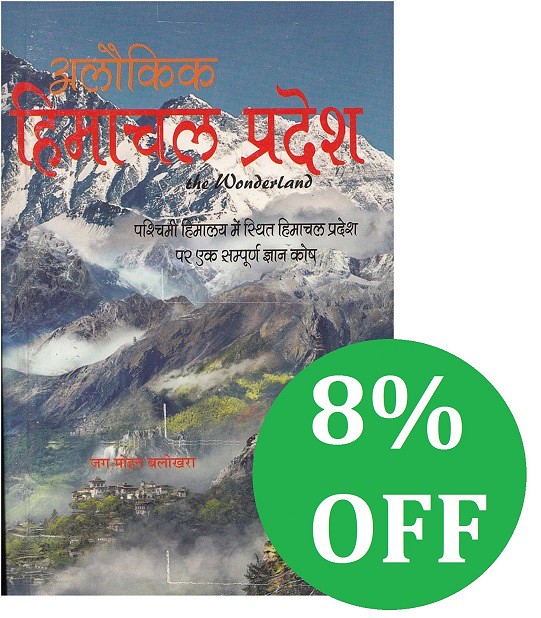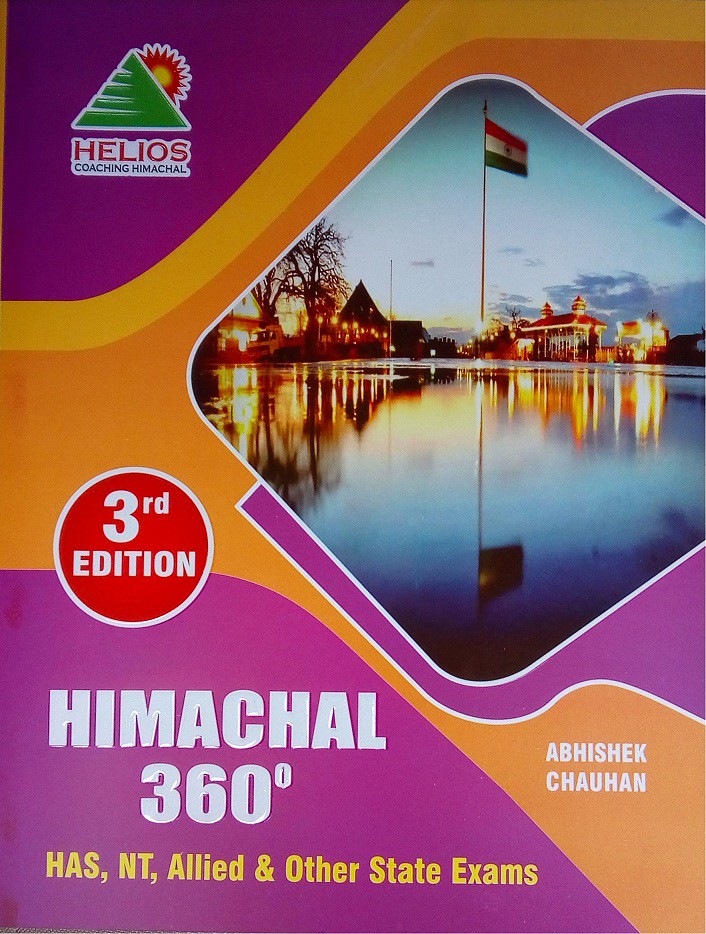
Paperback - Wonderland Himachal Pradesh(English) (Vol1&2)by Jag Mohan Balokhra HG Publication
Often bought together (HPPSC English Exams)
₹ 950 Exclude Delivery Charges
The Wonderland Himachal Pradesh - AN ENCYCLOPEDIA
A Survey of Geography, People, History, Politics, Administrative History, Culture, Tourism, Art and Architecture, Personalities, Places, Education, Status of Women, Wild Life, Planning and Economy of the State
A Book must for Academicians, Research Scholars, Candidates appearing in State Services Examinations and General Readers.
By Jag Mohan Balokhra
H.G. PUBLICATIONS
New Delhi-110062
Download Shunya eLearning Android App
PDF Fully Solved Papers for HPAS & NT Exam
Table of Contents
1. The Beautiful Land 1-68
Origin of Himalayas (1), Geography of Himachlal (5), Natural Resources of the Himalayas (16), Lakes in Himachal (23), River system (31), Rivers and tributaries (33), Hot Water Springs (45), Glaciers (47), Prominent Valleys (51), Peaks, Altitude and Location (56), Mountain Passes in Himachal (58), Environmental challenges in the Himachal Himalaya (61), Trekking routes in Himachal Pradesh (65), Smoke free Himachal (67)
2. The People 69-246
The ancient tribes (70), Modern tribes (75), Gaddis (80), Khampa (84), Angwal (89), Kinner or Kannaura (g7), Lahaulas (111), Gujjars (113), Jads (116), [(011 (117), Bard (120), Chamar (124), Ghana] (127), Bujm(131), Hali(134), Hesi (137), Bharai (14o), Sippi (143), Rihara (145), Turi (147), Acharaj (150), Bhat (151), Battarha (154), Khatik (154), Julaha (162), Kumhar (167), Nai (171), Sanhai (177), Saini (181), Dumna (186), Teli (186), Ghirath (189), Khushas element in Himachal (193), Brahmin (194), Rajput (199), Rangar (202), Rathi (207), Maliajan (209), Bond (211), Demographic profile 2001 census (217), Scheduled castes population (221), Scheduled tribes population (224), Religion based survey (226), Demographic profile 2011 census (228), Density of population (232), Literacy (233), Poor gender ratio (237), Saving girl child (241), Himachal pradesh scheduled castes and scheduled tribes development corporation (241), Area and language (242), Literature (245)
3. Social Life And Customs In Hlmachal Pradesh 247 - 300
Social customs (248), Marriage customs (248), Divorce system (253), Funeral customs (254), Birth ceremony (256), Dress (259), Ornaments and Jewellery (265), Folk Dances and Drama (270), The Musical Instruments (273), Festivals in Himachal (276), Fairs in Himachal Pradcsh (282), Malaria and Jamlu Devta (292), Jamlu Dtha (293), The Cult of Shirgul (Shrigul), Bijal and Mahasu Devtas (293), Shrigul Temples of Manal (296), Shrign] Temples at Dcona and Bandal (296), Bijat (296), Bijat and his sister Bijai (297), Mahasu Devta (297), Mahasu (in Sirinaur) (297), Mahasu (in the Shimla hills) (298)
4. Art And Architecture In Himachal 301-328
Indigenous KhasaArt (305), IndoiaryanArt(3o5), Indo’tibetanArt (306), Templc Architecture (307), Buddhist Sculpture (319), The hill Architecture (322), Painting (324), Schools of Painting (324), Chaimba Rumal (325), Painters in Himachal (326), HP. state Handloom and Handicrafts weavers apex cooperative society Ltd (328)
5. Status Of Women 329—368
Women in the politics of Himachal Pradesh (339), Women in the state council of Ministers (344), Women’s representation in the parliament (345), Women in local self Government (346), What causes low participation in politics (349), How to enhance participation ? (350), Empowerment of Women in Himachal (351), Rajiv Gandhi Scheme for Empowerment of adolescent Girls (366), H.P state Women Commission (367)
History of Hlmachal Pradesh 369-436
History (369), Literary Source (372), Hill States and Central Authority
(393), Turkish invasion of Kangra (394), Tughlaq Dynasty and Kangra (398), Timur Invasion of Kangra (402), Sur and Mughals invasion of Kangra (404), Mughals and Chanflm (412), Mughals and Sirmaur (413), Sikh and hill States (414), Maharaja Ranjit Singh and Hill States (415), Gurkhas and hill States (418), The Gurkhas and The British (421), Treaty of Sugauli (Sagauli) (423), Terms of Sugauli Treaty (424), Hill States and The British (427), Battle of Aliwal (430), Battle of Sobraon (431)
7. Districts Profile Bilaspur 437-450
River system (439), History (441), Economy (447)
Chamba 451-486
Mountain systems (451), History (455), Early History of Chamba (455), Inscriptions of Chamba State (479), Economy (481), Decadel Variations in Population since 1901—2011(486)
Hamirpur 487 - 494
History (489), Beonomy (490), Places of Historical interest (491), Decadel variations in Population since 1901-2011 (494)
Kangra 495 - 548
History (497), Genealogy of Kangra (513), Guler State (519), Jaswan State (522), Siba State (525), Datarpur State (527), Nurpur State (528), Bangahal State (539), Kutlehr State (540), Economy (541), Eminent persons from Dharamshala (547), Decadel variations in Population since 1901-2011 (548)
Kinnaur 549564
History (554), Decade] population growth since 1901-2011 (564)
Kullu 565-590
History (567), Genealogy of Kullu (580), Economy (582), Eminent persons from the KulluValley (589), Decadel Variations in population since 1901-2011 (590)
Lahaul- Spiti 591-618
Lahaul (591), Garzha (593), Swangla (594), Area and Situation (595), Spiti valley Glaciers (598), History (599), Lha~rabs (602), Religion (612), Marriage system (612), Economy(616), Lahaul‘spiti population since 1901-2011 (618)
Mandi 619 -648
Lakes (621), History (622), Suket (631), Economy (642), Decadel variations in populationsince1901-2011(648)
Shimla 649-688
River System (649), History (651), Balsan State (651), Bhajji State (652), Koti State (654), Bushahr State (655), Darkoti State (663), Tharoch State (664), Dhadi Fief (665), Kumharsain Fief (666), Khaneti Fief (668), Delath Fief (6769), Dhami State (670), J ubbal State (671), Rawingarh Thakurais (676), Ratesb Fief (677), Sangari State (677), Keonthal State (679), Ghund Fief (683), M adhan Hef (683), Theog Fief (684), Kotkhai Thakurai (684), Karangla Fief (685), Sairie Fief (685), Decadel variations inpopulationsince 1901—2011 (688)
Shimla -The Capital 689~706
History (689), The Romance ofthe Rickshaw (700), Shimla Development authority, Shim1a(7o6), Decadel Variations in population Shimla Town from 1901.2011 (706)
Sirmaur 707-732
River System and water resources (709), History (711), Economy (730), Decadel variations in population since 1901-2011(732)
Solan 733-758
History (733). Baghat (735), Baghal (ARK!) (738), Kunihar (742), Kuthar (743). 44), Beja (746), Mangal (747), Nalagarh (HINDUR) (748), Economy variations in population since 1901-2011 (758)
Appendixes 1559- 1628
-
The Himalayan Rivers &Their Place Of Origin (1559)
-
Some Of The Important Acts Passed By State Vidhan Sabha (1562)
-
State Award For Literature (1564)
-
Sports And Youth Awards (1570)
-
Gallantry Award Winners From Himachal (1572)
-
National Teacher Award Winners (1578)
-
State Award Winner Teachers (1584)
-
(8.a) legislative Assembly Constituencies (1592) (8. A-i) Assembly Constituencies AndTheir Extent (1592) (8. A—ii) Parliamentary Constituencies (1597) (8.b) Roll Of Speakers Vidhan Sabha (1598) (8.c) Deputy Speaker Of Vidhan Sabha (1598) (Sid) Himachal Vidhan Sabha Secretaries (1599) (8e) Chief Commessioner/lt. Governor Bx Governors (1600) (8.0 Roll Of Chief Ministers (1601) (8.3). Judicial Commissioner/ chief Justice (1602) (8.b) Lok Sabha Members From Himachal (1603) a Sabha Members From Himachal (1606)
-
Vice Chancellors HP. University, Shimla (1607)
THE BEAUTIFUL LAND
“He who goes to the bills, goes to his mother, the loving, nourishing bounteous mother".
— ‘The Puranas’
Himalayas are the greatest of all mountain systems which extend approximately to 2,410 kms. from North—West and to South—East their width is between 250 to 300 kms. The mountains of Peninsular India such as the Aravallis, the VSatpuras, the Vindhyas and the Nilgiris are over 1,000 million years old. The Himalayas are one of the youngest among the mountain systems in India. These are believed to be only 40 million years old. It took about 50 to 70 million years for this landmass to rise and to form the highest mountain system in the world.
The Himalayas in Hindu tradition are much more than a majestic moun» tain range that extends in a 2,410»km curve across South Asia. Hindus revere it not just for being a home to rare sanative herbs, nor even as a haven for excit- ing winter sports. To the Hindus this great grandfather~like figure has always been an abode of gods. So they referred to the Himalayas as devatma or God» souled. Gin—raj or the "King of Mountains", as the Himalayas is often called, is also a deity by itself in the Hindu pantheon. Hindus View the Himalayas as supremely sacred, as a corollary to seeing god in every atom of the universe. The mighty altitude of the Himalayas is a constant remembrance to the lotti- ness of the human soul, its vastness. a prototype for the universality of human consciousness. Even Mount Olympus in Greek mythology would pale in front of the reverence shown to the Himalayas in the Hindu mythology. Neither is Mount Fuji as significant to the Japanese as the Himalayas to Hindus.
ORIGIN OF THE HIMALAYAS
Many geologists have offered their views regarding the origin of the Himalayas. Among the early researchers mention may however be made of Sues, Burrad, Fuch, Valdiya, Wadia etc. It is believed that the Himalayas have originated as a result of sedimentation of a vast Tethys geosyncline that lay between the Gondwana landmass in the South and Angara landmass in the North. The soft sediments in the geosyncline were subsequently upheaved in several phases.
The origin of the Himalayas is related to continent—continent collision. Continent-continent collision occurs when two continental plates collide. As the Continents are carried by plates move, they move towards each other,
Product Details
- 1600
- Jag Mohan Balokhra
- 2018 January Edition
- ShunyaFoundation
- 59,009
- PYR93E11
- English
- Paperback
- H.G. Publication
- This book will be delivered via Indian Postal Services.
Customers also buy
HPPSC Exam Books
HPPSC Books collection for HPAS, Allied or Civil Services, Naib Tehsildar, Sub Inspector etc.
Explore HPPSC Books






